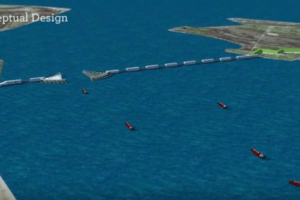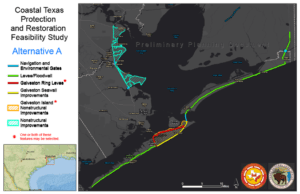Illustration: U.S. Army Corps of Engineers
BY STAS MARGARONIS
In 2017 Hurricane Harvey caused 51 inches of rain to fall on the Houston area causing massive flooding, shut down the Port of Houston, damaged petrochemical facilities and caused $125 billion worth of damage.
With that experience in mind, Texans are supporting a gigantic storm surge defense complex projected to cost as much as $37 billion, including a $12 billion storm surge barrier for Galveston Bay, popularly known as the ‘Ike Dike.’ The complex is designed to defend Texas cities, ports and petrochemical facilities from future storm surges, flooding and hurricanes following the destruction from Hurricanes Ike in 2008 and Harvey in 2017.
The push for the projected $37 billion complex in Texas comes at a time when:
* Mississippi river cities and ports say they need $12 billion in new flood protections.
* The Port and City of San Francisco say they will need $5 billion to rebuild the storm wall protecting port property and downtown from worsening storm surges
* The City of New Orleans has already been the recipient of a $14.5 billion storm surge protection complex built by the U.S. Army Corps of Engineers to prevent a repeat of the $125 billion in devastation suffered during Hurricane Katrina in 2005.[1]
* The U.S. Army Corps of Engineers has proposed a massive storm barrier complex to protect the New York and New Jersey Harbor estimated cost $119 billion so as to prevent a repeat of Hurricane Sandy which caused $70 billion worth of damage to the region in the Fall of 2012.[2]
The proposed $119 billion New York-New Jersey barrier is opposed by President Trump, who explained in a January 18th, Tweet that: “A massive 200 Billion Dollar Sea Wall, built around New York to protect it from rare storms, is a costly, foolish & environmentally unfriendly idea that, when needed, probably won’t work anyway. It will also look terrible. Sorry, you’ll just have to get your mops & buckets ready!”[3]
The plan for the Texas complex is being developed by the U.S. Army Corps of Engineers (USACE) and is officially known as the ‘Coastal Spine.’ It is expected to be submitted to Congress for funding in 2021 or 2022.
The project “includes a combination of ecosystem restoration (ER) and coastal storm risk management (CSRM) measures located throughout the 18 coastal counties of the Texas Gulf Coast,” according to a 2019 fact sheet issued by U.S. Army Corps of Engineers which is working in collaboration with the Texas General Land Office.
The Texas General Land Office led by Commissioner George Prescott Bush supports the project because “The Texas coast … is subject to coastal erosion, relative sea level rise, coastal storm surge, habitat loss and water quality degradation. These coastal hazards are placing the environmental and economic health of the coast at risk, which negatively impacts the state and national economy.”
Source: U.S. Army Corps of Engineers
The complex, developed as part of the Coastal Texas Study, is described in the 2019 fact sheet which states:
· The project study includes: “a “multiple lines of defense” approach/strategy that includes a combination of other structural and non-structural measures, as well as natural and nature-based features to form resilient, redundant, robust, and adaptable strategies that promote life safety. The specific measures proposed through the Study will be based on local site conditions and societal values.”
· The storm barrier will not have a negative impact on marine life within the Galveston Bay: “The modeling so far indicates that the height of tides in the bay would not be at levels that endanger fish and oyster populations.”
· The proposed features “reduce risk to the community at large, not just the concentration of industrial facilities in Houston.”[4]
Bob Mitchell, President of the Bay Area Houston Partnership, said that his organization has been supporting the Coastal Spine project since William Merrell, Chair of the Marine Sciences Department at Texas A &M University, Galveston came to him with the concept nine years ago. Merrell has been a leading advocate for the project.
Mitchell said that since that time, “our organization has been a major promoter of this storm surge project and the result is that “we expect the U.S. Army Corps of Engineers (USACE) to produce a report by 2021… that we can take to Congress for funding.”
Bob Mitchell
Mitchell explained that the public has “probably seen a figure of $32-37 billion dollars for the cost of the project. That projection encompasses the entire cost of coastal protections from the Sabine Pass to Brownsville. The storm surge barrier and gates across Galveston Bay are projected to cost between $9-12 billion dollars.”
William Merrell stated: “I became an advocate for a storm barrier to protect Galveston Bay after I rode out Hurricane Ike in Galveston back in 2008 and saw the damage from storm surges and flooding.
William Merrell
It is time that we got proactive on the issues of storm surges, flooding and climate changes and not focused on after-the-fact flood recovery through programs such as the FEMA (Federal Emergency Management Agency) process that politicians like to support…That takes a long time to work and often hurts the disadvantaged.
The flood protections built around New Orleans were the first time we were proactive and we need to do this in Texas with the Ike Dike.
National security isn’t just about protecting people being threatened by terrorists, it’s also about protecting people from the threats caused by catastrophic rains and storm surges and hurricanes… and climate change. It used to be we saw a 100-year flood once in every 100 years. Now it’s every 50 years. Here in Texas we have seen two catastrophic rains in recent years of 30+ inches.
Congress needs to get serious about infrastructure and about flood control protections and anticipate the problems that we are facing from climate change. The U.S. Army Corps of Engineers budget needs more money to address these problems…. We have seen the work the Dutch have done around defending against storm surges and we need to spend the money to see projects like the Ike Dike get built now…. climate change is getting worse and we need to get started protecting ourselves.”
Rationale For Storm Barrier
Mitchell said “The Coastal Spine is critical to our ability to protect 5.5 million people in the Houston area as well as the petrochemical industry within the region. That petrochemical industry is a national security asset for the United States. It includes 42% of special chemicals that include fertilizers, coatings, Theraflu, and other industrial applications. It also includes 20% of the United States gasoline resources, 60% of jet fuel, and between 70% -80% fuel used by the military. Protecting this industry is an important national and economic security priority.”
He also notes the importance of protecting the Port of Houston, which is at risk from hurricanes, and in 2018:
- Handled 69% of U.S. Gulf coast container cargo
- Is the largest Texas port with 96% market share of containers
Mitchell said that there are two possible outcomes for Congress to fund the USACE so as to build the storm barrier complex:
- “The funding could go the way of many traditional projects in which a fraction of the cost of construction is authorized each year and the construction could take up to 18 years to complete. The threat is too grave and we cannot allow that process to occur in the case of the Coastal Spine.”
- The project can be fully funded immediately for the full $12 billion dollar price tag similar to the expeditious funding of storm surge barriers that were built to protect New Orleans after Hurricane Katrina in 2005: “In that case following the deaths of 2000 people and the large-scale devastation inflicted on New Orleans persuading Congress that this calamity needed to be solved quickly by a new system of flood gates and storm surge protections. Congress authorized $14.5 billion dollars for USACE to design and build a system of storm protections that surround the city of New Orleans which is below sea level. The result was that within four years, the new protections were in place and New Orleans has been able to survive recent hurricanes without serious damage. That construction however, only protected around 400,000 people in downtown New Orleans, a city that is largely below sea level. … The State of Texas has a much more compelling argument for construction of the storm surge barriers because we are talking about protecting 5.5 million people and major fuel and chemical assets that impact national security and the U.S. economy. So, we would propose that Congress allocate Texas the $12 billion dollars it will need in order to build a storm surge barrier system based on U.S. national security.”
The threat of flooding and storm surge is addressed by this project in the following manner:
- “You stop the storm surge from the hurricane by closing the gates and keeping the storm surge out of the bay. This allows rain water flowing through the bayous and into the Houston Ship Channel to accumulate into Galveston Bay without the further factor of the storm surge pushing the water back into urban areas and impacting port operations and the petrochemical industry.
- When there is low tide and the storm surge has dissipated you can open the barriers and the storm gates will allow the accumulated water to flow out into the Gulf of Mexico. This helps to alleviate the threat of flooding.”
Priority Of Infrastructure Spending For Storm Surge And Flooding
Mitchell agrees that Congress needs to allocate more funding for infrastructure and for protections against worsening climate: “It’s absolutely correct that we need more funding for critical infrastructure projects that include defending from storm surges, flooding, and from changes in the climate. While I believe that the $12 billion for Texas provides the biggest bang for the buck, I recognize that other cities and communities are being faced with growing challenges to their infrastructure. These issues need to be addressed.”
Design Concerns
Mitchell says there were protests about the early design of some storm surge barriers because they would have been built in front of houses along the coast and have a negative impact among property owners along the Bolivar Peninsula and elsewhere. In response, “the plan was adjusted to follow the lead of the Netherlands by expanding revetments and building up the barrier protections through expanding beaches and allowing for the gradual incline of dunes to jut out into the Gulf of Mexico. This provides a more natural barrier that complements the topography of the coastline and does not negatively impact home and property owners. It will require, just as in the Netherlands, the deployment of dredging vessels to transport sediment and sand to spray along the coastline and to build up these barriers along the coast.”
Alternative Strategy: Galveston Bay Park Plan
An alternative to the Coastal Spine is the Galveston Bay Park Plan (GBPP) proposed by Jim Blackburn co-director, Severe Storm Prediction, Education, & Evacuation from Disasters (SSPEED) Center at Rice University and the author of the 2019 report: ‘Houston-Area Surge Flooding and its Effect on Regional and National Security’[5]
Jim Blackburn
In the report, Blackburn argues that the Coastal Spine proposal is very expensive and may not adequately protect Galveston Bay from the storm surge from rising sea levels and devastating storms such as the 2008 Hurricane Ike. Instead, Blackburn proposes GBPP utilizing a protections system including dredge materials to build wetlands and park lands within Galveston Bay that would cost between $3- $6 billion. He argues that the Coastal Spine would not sufficiently protect Galveston Bay from a storm surge that had a 15% greater wind speed than Hurricane Ike: “The spine system does reduce water levels in Galveston Bay, but sufficient water remains in the bay to cause substantial flooding along the western shoreline and in both the Bayport and Houston Ship Channel industrial complexes, where the water would rise to about 20 feet and flood many critical facilities.”[6]
Blackburn argues his less ambitious protection system can also be constructed faster than the Coastal Spine. He states that GBPP would not block the tidal flow between the Gulf of Mexico and Galveston Bay as the Coastal Spine and would thus minimize the impact on the marine ecology in Galveston Bay:
“The key to the GBPP is that the protection is proposed within the bay system to address surge from the Gulf as well as surge generated solely within the bay. This plan is compatible with navigation, and it essentially provides disposal capacity for the dredge material generated by widening the Houston Ship Channel, a current priority for oil exporters. These dredged material disposal areas could then be converted into either wetlands or park lands. Currently, the Port of Houston is seeking federal approval to widen the Houston Ship Channel, an action that would provide the construction material for the GBPP barrier wall. Thus, there may be cost sharing opportunities here.”
Blackburn argues that the GBPP will also provide protections for the populated areas of Houston and Galveston and protect Houston Ship Channel facilities including oil and gas facilities:
“The GBPP provides significant protection to the populated western side of Harris and Galveston Counties and to the industrial complexes at Bayport and the Houston Ship Channel. It does not provide flood relief for the undeveloped lands of Galveston and Chambers County and therefore will not induce new development behind its protection. It is intended to protect the already existing infrastructure and development. Further, the back-side levee surrounding the city of Galveston can be expanded at an approximate additional cost between $500 million and $1 billion to protect the Port of Galveston and Texas A&M University at Galveston.”
Mitchell insists there is no alternate proposal to the Coastal Spine project: “There is no alternate proposal. The proposal by professors at Rice University to create protections for the Western end of Galveston Bay will not protect the whole bay and the entire population and the petrochemical complex from a storm surge. This is therefore not an alternative solution, but a partial solution for some of the people. “
Texas A & M Study: Storm Barrier A Good Investment
The storm surge barrier, is a good investment, according to report published by two Texas A & M professors entitled “Economic impacts of storm surge and the cost-benefit analysis of a coastal spine as the surge mitigation strategy in Houston-Galveston area in the USA” which they summarized in a 2019 article.[7]
The study authors are Meri Davlasheridze, an assistant professor at Texas A&M University, Galveston who focuses on the economics of natural hazard impacts and mitigation, while Wesley Highfield an associate professor at Texas A&M University, Galveston focuses on the analysis and mitigation of natural hazards.[8]
Davlasheridze said that the report looked at a number of different scenarios and found that the Galveston Bay storm barrier would substantially benefit the region by mitigating the effects of storm surges from hurricanes such as from Hurricane Ike in 2008 and Hurricane Harvey in 2017.
Meri Davlasheridze
She noted, however, that the likelihood of a 500-year storm surge event is increasing and that damage will worsen with higher sea levels in the future.
Reducing Hazard To Port Operations And Petrochemical Industry
In the July 2019 summary entitled ‘Coastal spine could lessen impact of most hurricanes,’ the professors looked at the impact of damage to residential property in the Houston/Galveston areas that included Harris, Galveston and Chambers counties and found:
“The presence of a coastal barrier reduced damage from storm surge-based flooding by between 70 and 90 percent. These percentage figures represent between $423 million for a smaller, more likely hurricane, to $5.6 billion for a larger, less likely hurricane. For a storm that mimics the surge of Hurricane Ike, residential property damage was reduced from $2.9 billion to $135 million, a 95 percent loss avoidance.”
Impact To Petrochemical Plants
When the study was expanded to include the economic impacts of storm surges on petrochemical plants in the Houston area, the researchers found:
“The addition of petrochemical and industrial plants adds structures worth between $8.7 billion and $17.5 billion that are exposed to storm surge. Further, because many plants on the coastline are forced to shut down because of the threat of a storm alone, irrespective of damage, additional indirect costs are incurred…. For the most conservative scenario of an 18-day shutdown, total losses range from $400 million for a likely hurricane, to $13 billion for a lower probability storm.”
The study found that “these effects are significantly mitigated with a coastal barrier: a 100 percent reduction in total losses for smaller storms to a 76 percent reduction in larger, less likely storms.”
The researchers looked at the long-term economic impact to the Texas economy. They noted that “economic effects of a storm surge are not isolated to the area flooded by the surge: “Our local and regional economy is intricately linked to economies in other regions and states, and the ripple effect shows up in Texas’ and the nation’s gross domestic product, among other measures.”
Long-term Impact On Economy & Exports
The researchers found: “when considered over a 50-year time frame, our projections show that without coastal protection, storm surges are likely to decrease Texas’ Gross State Product by 8 percent — which is to say, $863 billion.”
As a result, “a coastal spine substantially mitigates these economic impacts. Further, all macroeconomic indicators — except for government expenditures — will also decline, with the value of net exports suffering the most profound decline by an estimated 13 percent, corresponding to $160 billion loss.”
The Exposure Of Houston To Flooding
In their summary, Davlasheridze and Highfield noted that the storm surge barrier does not solve the problem of chronic flooding in the Houston and Galveston Bay areas: “To be clear, it is not a silver bullet to address the larger and increasingly challenging issues related to flooding in the region — there remains a substantial amount of long-term, comprehensive planning and implementation of many different flood mitigation techniques to address our larger flooding problems.”
Mitchell agrees: “There continues to be a problem of flooding in the region. There are legitimate concerns about the ability of the bayous to efficiently flow in a rain event and relieve the pressure of rainfall during a major event. For this reason, we have supported the Clear Creek Watershed project since 1961 in an effort to relieve flooding from high rainfalls and allow a natural outfall of rain. That project would have cost around $350 million dollars back then, but has been the subject of incremental increases in the U.S. Army Corps budget process and despite a recent infusion of $350 million will still not be complete.”
An environmental group ‘Save The Buffalo Bayou’ cited the research of Texas A & M Galveston professor Sam Brody arguing that too much residential and commercial development in flood prone areas of Houston has undermined the ability of bayous to provide natural run-offs of water during heavy rainfall: “As wetlands have been lost, the amount of impervious surface in Harris County increased by 25 percent from 1996 to 2011,” Thus, the spread of housing and concrete fails to absorb rainfall and allow the water to flow gradually into Galveston Bay. Instead, the high degree of development creates manmade (sic) hard surfaces, preventing water from being naturally absorbed. The result is more and worse flooding. The group argues that flooding will remain a serious problem until flood mitigation efforts are fully addressed. At the very least, the group argues it is vital “to remove the 140,000 homes that remain in the 100-year floodplain.”[9]
Dana Moore
Borrowing on the Dutch model of building inland reservoirs to reduce flooding, a graduate of the University of Texas at Austin Schools of Architecture and Liberal Arts, Dana Moore, has proposed, in her thesis ‘The Sentinel City,’ a way to relieve the flooding pressures on Houston by developing a string of new carless housing developments along existing rail lines, each containing a reservoir. Moore proposes a network, of what she calls the ‘String of Pearls’ be built around the Houston area over a period of years using the reservoirs to absorb heavy rainfall during storms. The water would be released later outside of the Galveston Bay, thus relieving Houston’s network of small rivers known as bayous including the Buffalo Bayou that flows into the Houston Ship Channel and then into Galveston Bay. The idea would be for the newer developments to replace older developments nearer the Ship Channel and allow creation of more open space and less concrete so that rain water would be absorbed into the ground and flow more gradually into the sea after storm surge has abated. [10]
The result, she argues, would reduce the flooding effect on Houston and the Houston Ship Channel:
“The String of Pearls is a chain of pro-development pods centered around detainment reservoirs to relieve the pressure on the overburdened bayou system. The String of Pearls catches and stores water during rainfall events, and releases it outside of the highly vulnerable Galveston Bay, effectively circumventing the compound flood zone of central Houston along the Ship Channel. They augment a modified version of the Ike Dike proposal, filling its gaps in scope.”
Conclusion
Mitchell concedes that weather patterns are changing but is unsure whether they are caused by human activity: “We have to recognize that something is happening with our climate as we have seen a change from average rainfall events that have gone from 2-3-inch events in the past to become 5-7 inches events… Even more extreme was the 51 inches of rainfall that fell at one time from Hurricane Harvey in 2017. There is no way that you can defend against a 51-inch rain event. Now, I may be naïve in saying this, but while I believe that something is happening in Nature, I do not know whether it is man-made or not.”
( Editor’s note: A version of this story appeared in the American Journal of Transportation)
Footnotes
[1]https://www.thebalance.com/hurricane-katrina-facts-damage-and-economic-effects-3306023
[2] https://www.nationalgeographic.com/environment/natural-disasters/reference/hurricane-sandy/, https://newyork.cbslocal.com/2020/01/21/new-york-119-billion-sea-wall-proposal/
[3] https://www.nbcnewyork.com/news/local/trump-calls-nyc-119b-seawall-proposal-costly-foolish-in-tweet/2261935/
[4] https://coastalstudy.texas.gov/resources/information-tools/coastal-tx-misconceptions.pdf
[5] https://www.bakerinstitute.org/media/files/files/a504bad8/bi-research-blackburn-houstonflooding-050119.pdf
[6] https://cee.rice.edu/jim-blackburn
[7] https://www.pressreader.com/usa/houston-chronicle-sunday/20190721/281925954603048
[8] https://www.tamug.edu/mars/faculty-bios/MeriDavlasheridze.html







